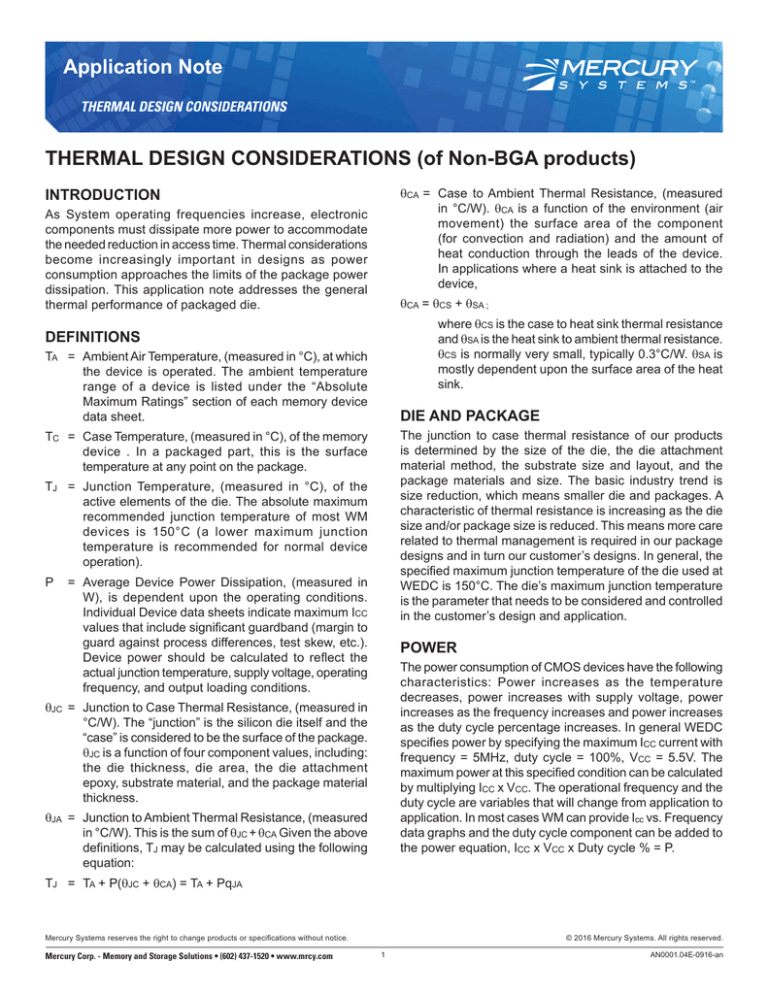
Application Note
THERMAL DESIGN CONSIDERATIONS
THERMAL DESIGN CONSIDERATIONS (of Non-BGA products)
CA = Case to Ambient Thermal Resistance, (measured
in °C/W). CA is a function of the environment (air
movement) the surface area of the component
(for convection and radiation) and the amount of
heat conduction through the leads of the device.
In applications where a heat sink is attached to the
device,
INTRODUCTION
As System operating frequencies increase, electronic
components must dissipate more power to accommodate
the needed reduction in access time. Thermal considerations
become increasingly important in designs as power
consumption approaches the limits of the package power
dissipation. This application note addresses the general
thermal performance of packaged die.
CA = CS + SA ;
where CS is the case to heat sink thermal resistance
and SA is the heat sink to ambient thermal resistance.
CS is normally very small, typically 0.3°C/W. SA is
mostly dependent upon the surface area of the heat
sink.
DEFINITIONS
TA = Ambient Air Temperature, (measured in °C), at which
the device is operated. The ambient temperature
range of a device is listed under the “Absolute
Maximum Ratings” section of each memory device
data sheet.
DIE AND PACKAGE
The junction to case thermal resistance of our products
is determined by the size of the die, the die attachment
material method, the substrate size and layout, and the
package materials and size. The basic industry trend is
size reduction, which means smaller die and packages. A
characteristic of thermal resistance is increasing as the die
size and/or package size is reduced. This means more care
related to thermal management is required in our package
designs and in turn our customer’s designs. In general, the
specified maximum junction temperature of the die used at
WEDC is 150°C. The die’s maximum junction temperature
is the parameter that needs to be considered and controlled
in the customer’s design and application.
TC = Case Temperature, (measured in °C), of the memory
device . In a packaged part, this is the surface
temperature at any point on the package.
TJ = Junction Temperature, (measured in °C), of the
active elements of the die. The absolute maximum
recommended junction temperature of most WM
devices is 150°C (a lower maximum junction
temperature is recommended for normal device
operation).
P
= Average Device Power Dissipation, (measured in
W), is dependent upon the operating conditions.
Individual Device data sheets indicate maximum ICC
values that include significant guardband (margin to
guard against process differences, test skew, etc.).
Device power should be calculated to reflect the
actual junction temperature, supply voltage, operating
frequency, and output loading conditions.
POWER
The power consumption of CMOS devices have the following
characteristics: Power increases as the temperature
decreases, power increases with supply voltage, power
increases as the frequency increases and power increases
as the duty cycle percentage increases. In general WEDC
specifies power by specifying the maximum ICC current with
frequency = 5MHz, duty cycle = 100%, VCC = 5.5V. The
maximum power at this specified condition can be calculated
by multiplying ICC x VCC. The operational frequency and the
duty cycle are variables that will change from application to
application. In most cases WM can provide Icc vs. Frequency
data graphs and the duty cycle component can be added to
the power equation, ICC x VCC x Duty cycle % = P.
JC = Junction to Case Thermal Resistance, (measured in
°C/W). The “junction” is the silicon die itself and the
“case” is considered to be the surface of the package.
JC is a function of four component values, including:
the die thickness, die area, the die attachment
epoxy, substrate material, and the package material
thickness.
JA = Junction to Ambient Thermal Resistance, (measured
in °C/W). This is the sum of JC + CA Given the above
definitions, TJ may be calculated using the following
equation:
TJ = TA + P(JC + CA) = TA + PqJA
Mercury Systems reserves the right to change products or specifications without notice.
Mercury Corp. - Memory and Storage Solutions • (602) 437-1520 • www.mrcy.com
© 2016 Mercury Systems. All rights reserved.
1
AN0001.04E-0916-an
Thermal Design Considerations
THERMAL MANAGEMENT TECHNIQUES
from the package to a material with a low thermal resistance.
Thermal vias are used to assist in removing the heat that is
dissipated from the power and ground leads of the device.
Thermal vias need to be connected to the power and ground
planes of the PCB.
To obtain a maximum operating temperature and at the same
time keep the die junction temperature below its specified
maximum the user may need to reduce the case to ambient
thermal resistance, CA. There are three basic methods for
reducing CA, heat sinking, forced air cooling and thermal
vias in the PCB. Heat sinking can be done by making contact
Mercury Systems reserves the right to change products or specifications without notice.
© 2016 Mercury Systems. All rights reserved.
Mercury Corp. - Memory and Storage Solutions • (602) 437-1520 • www.mrcy.com
2
AN0001.04E-0916-an


